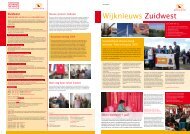freakonomics
freakonomics
freakonomics
You also want an ePaper? Increase the reach of your titles
YUMPU automatically turns print PDFs into web optimized ePapers that Google loves.
agels cost one dollar each, cream cheese included) than with the context of the “crime.”<br />
The same office worker who fails to pay for his bagel might also help himself to a long<br />
slurp of soda while filling a glass in a self-serve restaurant, but he is very unlikely to<br />
leave the restaurant without paying.<br />
So what do the bagel data have to say? In recent years, there have been two noteworthy<br />
trends in the overall payment rate. The first was a long, slow decline that began in 1992.<br />
By the summer of 2001, the overall rate had slipped to about 87 percent. But immediately<br />
after September 11 of that year, the rate spiked a full 2 percent and hasn’t slipped much<br />
since. (If a 2 percent gain in payment doesn’t sound like much, think of it this way: the<br />
nonpayment rate fell from 13 to 11 percent, which amounts to a 15 percent decline in<br />
theft.) Because many of Feldman’s customers are affiliated with national security, there<br />
may have been a patriotic element to this 9/11 Effect. Or it may have represented a more<br />
general surge in empathy.<br />
The data also show that smaller offices are more honest than big ones. An office with a<br />
few dozen employees generally outpays by 3 to 5 percent an office with a few hundred<br />
employees. This may seem counterintuitive. In a bigger office, a bigger crowd is bound<br />
to convene around the bagel table, providing more witnesses to make sure you drop your<br />
money in the box. But in the big-office/small-office comparison, bagel crime seems to<br />
mirror street crime. There is far less street crime per capita in rural areas than in cities, in<br />
large part because a rural criminal is more likely to be known (and therefore caught).<br />
Also, a smaller community tends to exert greater social incentives against crime, the main<br />
one being shame.<br />
The bagel data also reflect how much personal mood seems to affect honesty. Weather,<br />
for instance, is a major factor. Unseasonably pleasant weather inspires people to pay at a<br />
higher rate. Unseasonably cold weather, meanwhile, makes people cheat prolifically; so<br />
do heavy rain and wind. Worst are the holidays. The week of Christmas produces a 2<br />
percent drop in payment rates—again, a 15 percent increase in theft, an effect on the<br />
same magnitude, in reverse, as that of 9/11. Thanksgiving is nearly as bad; the week of<br />
Valentine’s Day is also lousy, as is the week straddling April 15. There are, however, a<br />
few good holidays: the weeks that include the Fourth of July, Labor Day, and Columbus<br />
Day. The difference in the two sets of holidays? The low-cheating holidays represent<br />
little more than an extra day off from work. The high-cheating holidays are fraught with<br />
miscellaneous anxieties and the high expectations of loved ones.<br />
Feldman has also reached some of his own conclusions about honesty, based more on his<br />
experience than the data. He has come to believe that morale is a big factor—that an<br />
office is more honest when the employees like their boss and their work. He also believes<br />
that employees further up the corporate ladder cheat more than those down below. He got<br />
this idea after delivering for years to one company spread out over three floors—an<br />
executive floor on top and two lower floors with sales, service, and administrative<br />
employees. (Feldman wondered if perhaps the executives cheated out of an<br />
overdeveloped sense of entitlement. What he didn’t consider is that perhaps cheating was<br />
how they got to be executives.)









